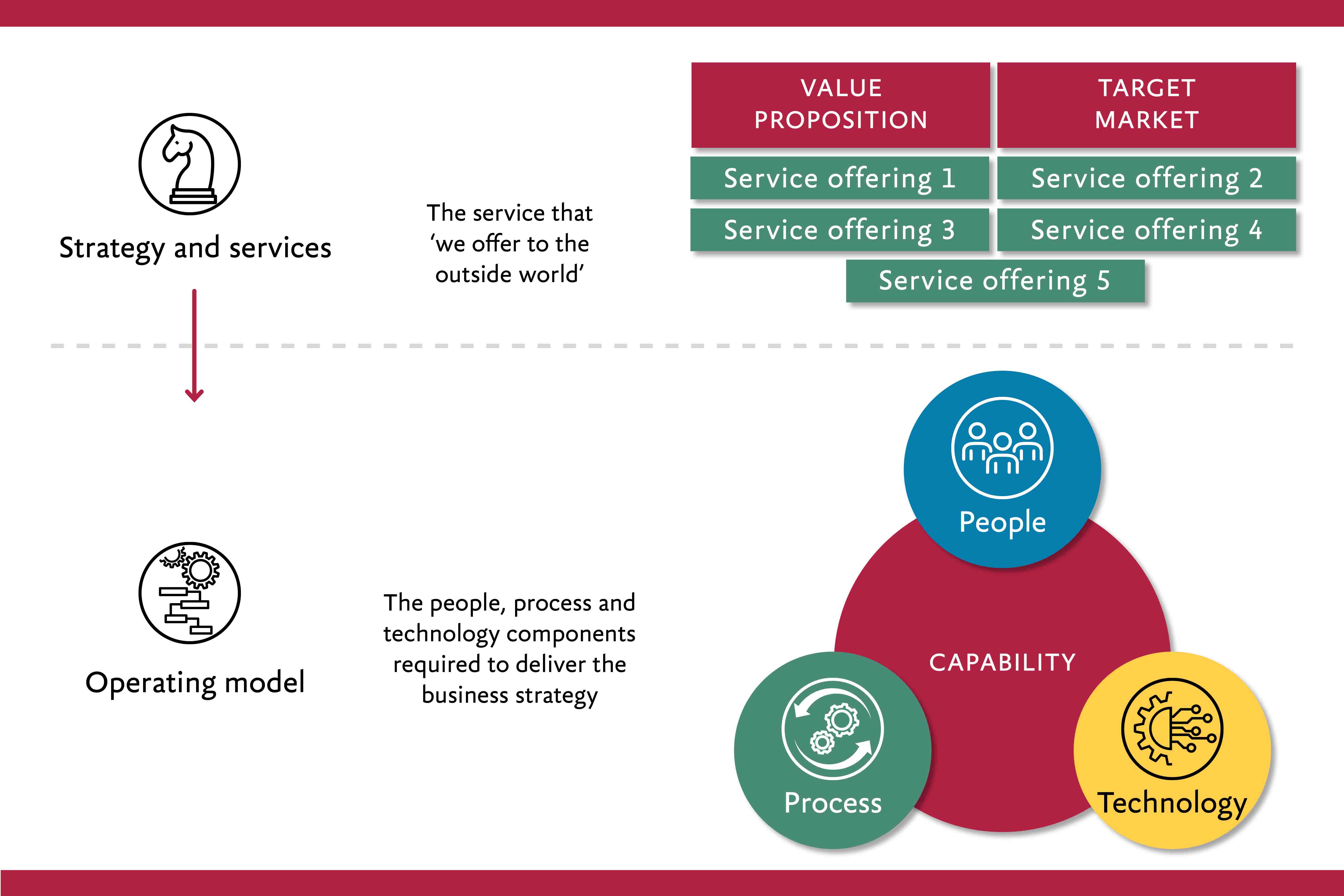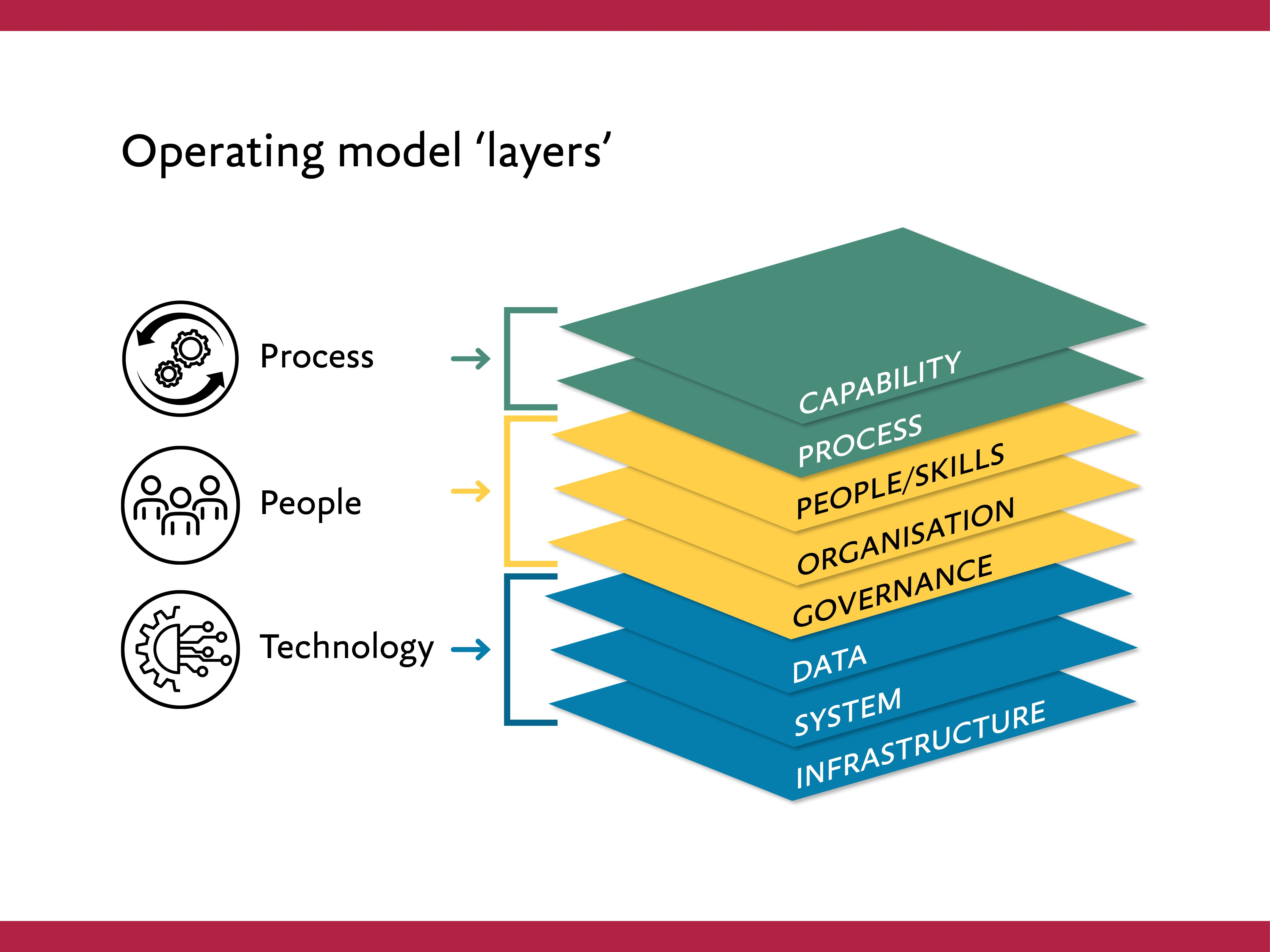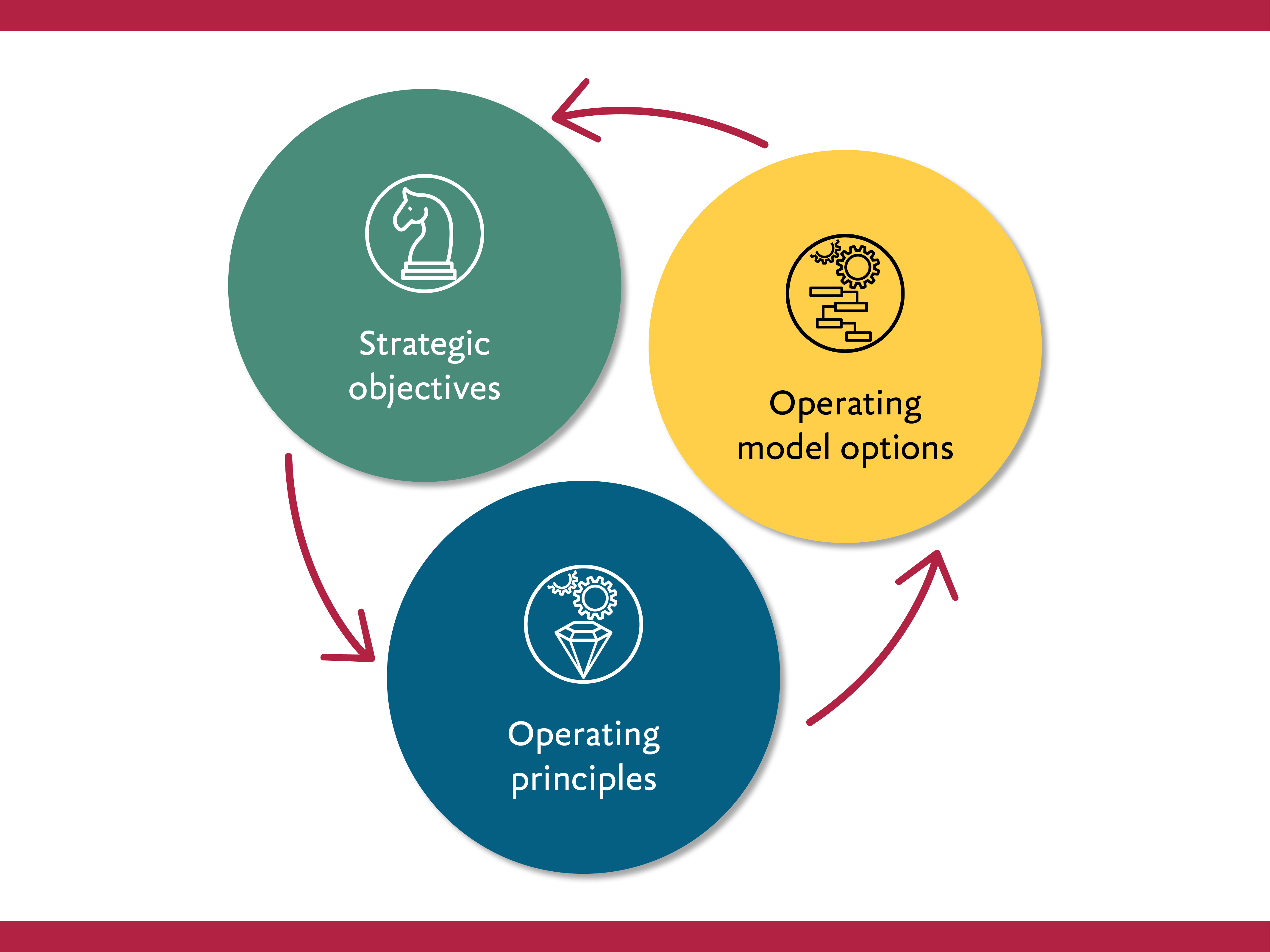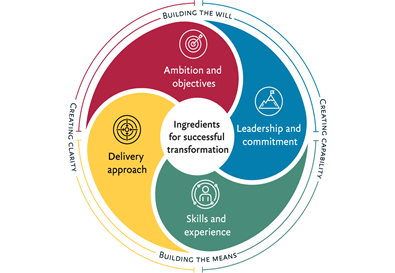Current events force many organisations to make rapid, tactical changes to their existing operating models. Some of these changes may be temporary but others may become permanent. How do you make the right decisions to ensure your operating model remains in alignment with your long-term business goals? Discover the five key steps.
Alignment should be the key aim as you assess changes to your operating model (across the people, processes and technology components) – both in terms of supporting your overall strategy and ensuring all sub-components of the model are working together. It is rare that you can change one component without impacting the others.
While it is tempting to move quickly with changes in such a rapidly evolving situation, it is important that you objectively evaluate options. You need to ensure that the changes you make will support the business in the longer-term as much as it will in the short-term. This is not about slowing down the decision-making process but applying enough rigour - asking the right questions in the right order.
In periods of uncertainty, any approach needs to be agile and responsive, ready to adapt at short notice to new, emerging information.
1. Understand the outside world
It may be that current circumstances have already changed the markets you operate in, or the value of your products or services has fundamentally shifted in the eyes of your current, or prospective, customers. Customers can be external or internal – thinking about your customer offer is the right starting point whether you are designing an operating model for your entire business, or just for a function within it. We have seen inventive examples of this: engineering companies innovating and manufacturing equipment for the healthcare sector, fitness equipment companies facing a soaring demand from individuals instead of commercial gyms, or pharmaceutical companies building R&D alliances.
When reviewing your operating model, we would recommend anchoring your thinking against an initial set of first order questions around how your target market, customer value proposition and channel mix are changing.
- How will our customer base change?
- Where will they be located and how will they want to access our products and services?
- Why should they buy from us rather than our competitors?
In other words, how will the 'outside world' change and what does this mean for us?
2. Agree the critical areas of focus
Having taken a look outside, you can use the results of this activity to decide which elements of your operating model require the heaviest focus to address your strategic challenges, and identify where the quick wins might be.
What capabilities do you need? For example, do you need to increase your digital presence and delivery capability? What might be the operational changes you need to accommodate permanent home working for parts of your workforce? Or does our governance model need to change to enable more frequent and quicker decision making at a local or regional level?
The term ‘operating model’ can mean different things to different people. A suggested lens we use is one that breaks out the layers of your business, covering processes, people and technology, and their sub-components.
In thinking through the focus areas for your business, it pays off to consider the impact on all of the layers of your operating model, as the components need to work in harmony. For example, you cannot improve your online delivery capability without addressing the organisation, skills, processes, systems and data that enable it.
| CLIENT EXAMPLE |
|---|
| A global consumer goods client saw a big shift towards ecommerce buying channels. Berkeley supported them to develop a better understanding of what the future of great content and online experience will look like and how they can best produce, deploy and optimise that content to drive their ecommerce growth. This work impacted all of the process, people and technology layers in their ecommerce operating model. |
3. Define your operating principles
This work can typically be completed in parallel with step two. A carefully drafted set of principles, typically between half a dozen to a dozen, helps align the leadership team around objective criteria for assessing and designing changes to the organisation’s operating model. It will set an agreed direction of travel to be followed to meet the business ambition.
Good principles often highlight specific types of decisions that the new operating model should facilitate e.g.
- “Product roadmap decisions will be driven by clearly-defined customer requirements and a well-defined business case for innovation.”
- “We will buy, instead of build, IT capability."
Clarify who is doing what in the new operating model e.g.
- “Divisional Sales & Marketing will drive margin, mix and volume through divisional sales plans, supported by Group Marketing.”
- “We will have a single supply chain function responsible for fulfilling demand across all divisions.”
A good set of principles should be specific to the organisation and memorable; abundantly obvious statements, like “make customers happy” don’t really give any direction or help you to say ‘no’ when it comes to your options analysis (see step four below).
What are the critical enablers to ensuring success of the strategy? e.g. “Our data will need to provide visibility of our customers across all of our channels and business processes.”
For example: “We will shift our culture from an operations to customer-driven mindset and redesign our performance metrics to support that.”
4. Evaluate the options for your operating model
This stage enables you to form the directional view of the operating model changes that are required to support your business goals. In evaluating the options it is useful to provide an assessment, outlining pros and cons, to build a wider consensus behind the decisions. You can sometimes move faster than you thought possible, and so the benefit of rapid deployment of new features or capabilities, even if not perfect, may well outweigh the potentially long process of seeking perfection.
Whatever options there are for your operating model, the real value comes from alignment. Without a conscious effort to develop a cross-functional operating model and consider all layers, the outcome can result in functional silos growing in isolation, resulting in a lack of alignment within the components of the operating model or with the agreed business aspirations. Therefore, as you go through the process of evaluation keep challenging yourself against the following questions:
- Are the options still aligned with the strategic objectives?
- Is there still alignment with the agreed principles, or is there tweaking required?
- Are the layers of the operating model working in harmony?
In the current environment, this process is not a one-off but something that needs to be stress-tested against a range of scenarios, as well as being capable of being adapted at short notice to new/emerging information. However, by constantly iterating through this process the result will be a well thought-through outcome, aligned to your business strategy and that you can be confident will be deliverable and successful in the ‘real world.’

| CLIENT EXAMPLE |
|---|
| We have worked with a client to define their operating principles around governance. This included features such as 'being professional' e.g. having the required capability to be responsive and transparent. Governance processes have been further streamlined to reduce time from ‘insight to action’, with more frequent but shorter leadership team meetings and more effective delegation to lead responses locally. With these changes, the client is better able to respond to fast-moving challenges. |
5. Design and implement your operating model
For the chosen option, the final step is to complete the design and describe how the new organisation takes shape or capabilities implemented over a number of set periods of time. In designing the operating model, it is beneficial to do it with implementation in mind. This will allow you to consider quick wins that can be deployed rapidly, for example, in response to immediate challenges vs. transition states that can happen over a longer period of time.
A key aspect of the implementation plan is to keep it pragmatic and implementable. For example, you need to consider the effort required from the business people to achieve the changes while keeping the business as usual operations moving. Alternatively there may be a need to invest in a new capability during a time when any spend is under a heavy scrutiny. Building a wider consensus within the business to support and help drive forward the proposed changes is therefore vital. Otherwise there is likely to be resistance or challenge at every step of the delivery.
Change management needs to be part of the implementation roadmap, too. Any change in an operating model is inherently linked to ways in which people work and operate. Explaining the changes required, building buy-in and equipping the individuals will all need to be considered to achieve a lasting change.
| CLIENT EXAMPLE |
|---|
| A consumer goods client had been on a strategic journey to reimagine how they connect with consumers across key digital touchpoints on the path to purchase. The leading brands had developed their digital strategies; however, little work had been done on defining the future operating model that would support the business and IT once the programme had completed. We led the definition of the future operating model for digital marketing capabilities across local and global functions. Working across global IT and business teams we modelled the future organisation required to activate, embed and support the new capabilities. |
A well-designed operating model aligned to your evolving business strategy
Current circumstances are likely to have had an impact on the strategy of many businesses, and so a well thought-through operating model, aligned to your evolving business strategy, is as important as ever. Making quick decisions about operating model changes, especially in the most challenging of times, can be difficult given the need to maintain that alignment. Applying just enough rigour and asking the right questions normally means you can establish a coherent set of changes out of something that could have otherwise become a disorderly situation.











